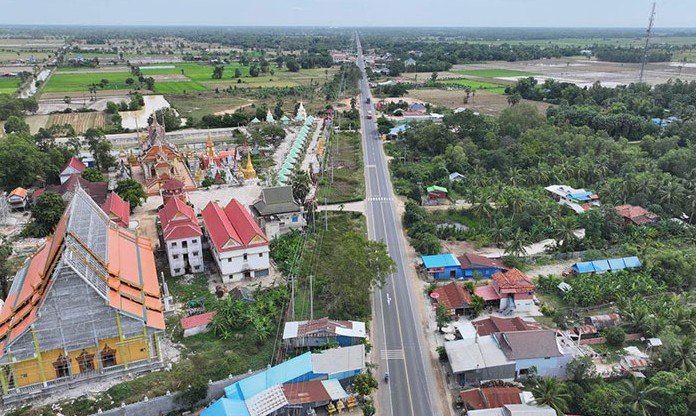Cambodia is in the midst of an infrastructure boom, pouring billions into expressways and high-speed rail projects in an ambitious bid to transform its economy and strengthen regional connectivity. With an eye on becoming a logistics hub in Southeast Asia, the government is betting on modern transportation networks to accelerate trade, slash travel times, and attract foreign investment. But as the country fast-tracks these projects, challenges in financing, execution, and regional integration loom large.
Expanding the Road Network
The country’s national road network grew by nearly 300 kilometers last year, bringing the total to over 20,307 kilometers, according to the Ministry of Public Works and Transport (MPWT). Under the $36.6 billion Comprehensive Intermodal Transport and Logistics System (CITLS) 2023–2033 master plan, Cambodia is aggressively expanding its transport infrastructure, emphasizing expressways and railways to enhance domestic mobility and regional trade.

“Our commitment is to turn Cambodia into a regional transport hub,” said Phan Rim, spokesman for MPWT. “These projects will not only improve connectivity but also unlock economic opportunities for businesses and investors.”

Two major expressways are already reshaping the country’s transport landscape. The $2 billion Phnom Penh-Sihanoukville Expressway, a 190-kilometer route linking the capital to its sole deep-sea port, has drastically reduced travel time from five hours to under two. The $1.7 billion Phnom Penh-Bavet Expressway, which will span 135 kilometers and link Cambodia to Vietnam’s commercial hub, Ho Chi Minh City, is under construction and expected to drive trade growth between the two nations.

By 2033, Cambodia plans to build nine expressways and upgrade 85 national and provincial roads at a total cost of $13.6 billion. These projects, largely financed through public-private partnerships (PPP), are seen as critical to integrating the country with the broader ASEAN trade network.
Trade and Logistics in High Gear
The impact of these infrastructure projects is already evident. The Phnom Penh-Sihanoukville Expressway has cut logistics costs by nearly 30%, making Cambodia more competitive as a manufacturing and export base, according to Duch Darin, an economist at the Royal Academy of Cambodia.
The upcoming Phnom Penh-Bavet Expressway is expected to yield similar benefits. Trade between Cambodia and Vietnam surged 16.5% year-on-year, reaching $45.06 billion in the first ten months of 2024, according to the General Department of Customs and Excise. As the expressway nears completion, cross-border trade is poised for further expansion.

To complement the road network, Cambodia is pushing forward with a $2.5 billion expressway linking Phnom Penh to Siem Reap and Poipet on the Thai border. The project is expected to strengthen trade corridors and boost the tourism sector, which remains a key pillar of the country’s economy.
High-Speed Rail: An Ambitious Bet
While expressways are reshaping Cambodia’s road network, the government is also placing a strategic bet on modernizing its rail system. The CITLS master plan earmarks $10 billion for eight railway projects, aiming to enhance connectivity, reduce freight costs, and support industrial growth.

A key focus is the Phnom Penh-Poipet railway, a 382-kilometer route that serves as Cambodia’s main trade link with Thailand. The government plans a $4 billion overhaul to transform the line into a high-speed rail corridor, cutting travel time from six hours to 2.5.
Meanwhile, discussions are underway on a high-speed rail link between Phnom Penh and Ho Chi Minh City, which could slash travel time from six hours to under two and provide a crucial alternative to congested road networks.

“The demand for reliable and efficient transport is increasing, and high-speed rail is a key element of our long-term development strategy,” said Public Works and Transport Minister Peng Ponea. “We are
working with international partners to secure funding and technical expertise.”

Additional railway projects include a planned connection between Phnom Penh and the new Techo International Airport in Kandal Province, as well as a link between Siem Reap and Angkor International Airport, catering to Cambodia’s growing tourism sector.
Financing and Regional Integration
Infrastructure development remains central to Cambodia’s Vision 2050, which aims to transition the country to an upper-middle-income economy by 2030 and a high-income economy by 2050. However, funding these massive projects remains a challenge.
China’s Belt and Road Initiative (BRI) has played a significant role in financing Cambodia’s expressway and rail projects, with the China Road and Bridge Corporation (CRBC) leading construction efforts. But as Cambodia seeks to diversify its financing sources, it is looking to Japan, South Korea, and international development banks for additional investment.

“Public-private partnerships are crucial to sustaining infrastructure investment at this scale,” said economist Hong Vanak. “Cambodia must balance foreign financing with domestic revenue generation to mitigate debt risks.”

Some experts suggest that Cambodia could consider issuing infrastructure bonds to raise capital for large-scale projects—a model successfully adopted by countries such as the United States and Chile.
The Roadblocks Ahead
Despite its ambitious plans, Cambodia faces hurdles in executing its infrastructure vision. Land acquisition challenges, environmental concerns, and financing gaps have caused delays in some projects. The Phnom Penh-Sihanoukville Expressway, for example, encountered initial resistance from local communities, requiring additional compensation measures to proceed.
Integrating Cambodia’s growing transport network with regional logistics systems also presents regulatory and logistical challenges. Streamlining customs and border clearance procedures with Thailand and Vietnam will be critical to maximizing efficiency and boosting trade flows.
“Seamless cross-border transport is essential for these projects to deliver their full economic potential,” said MPWT’s Phan Rim. “We are working on harmonizing regulations and improving trade facilitation measures.”
A New Era for Cambodia’s Economy
As Cambodia accelerates its infrastructure expansion, the impact is already being felt across key sectors. Expressways are cutting travel times and lowering costs, while high-speed rail promises to modernize regional logistics. If successfully executed, these developments will not only spur economic growth but also improve the quality of life for millions of Cambodians.
The road to transformation is far from smooth, but with a clear roadmap and continued investment, Cambodia is on course to become a major transport and logistics hub in Southeast Asia by 2033. For now, the country is pressing forward—full speed ahead.


